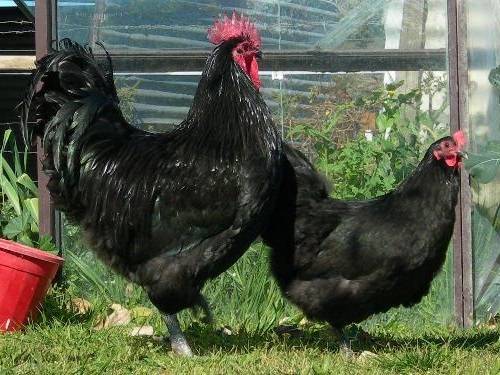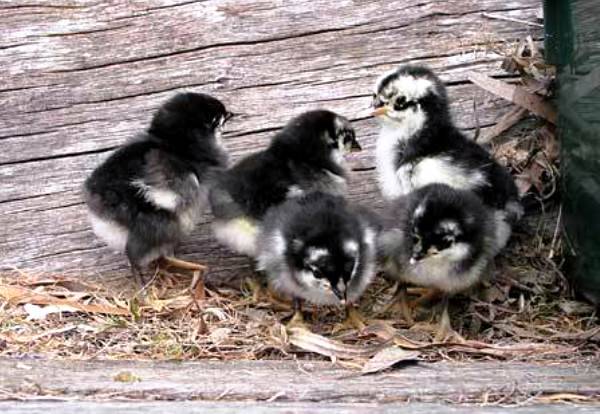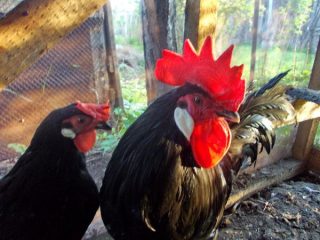Content
Australorp is a breed name compiled from the words “Australian” and “Orlington”. The Australorp was developed in Australia around 1890. The basis was the black Orlington imported from England. The first Australorps were exclusively black in color. The black Australorp is still the most common and well-known variety today.
But the Australorp cannot be called a “purebred” Orlington of the Australian line. When breeding the Australorp to improve the productive qualities of the Orlington between 1890 and 1900, Rhode Island Reds were used. Somewhat later, the Menorcan breed was added to the Australorps chickens, white leghorn and Lanshan chicken. There are even mentions of Plymouth Rock infusion. Moreover, the English Orlington itself is also a hybrid of Menorca, Leghorn and Lanshan chickens. In other words, backcrossing was used when breeding Australorp.
The photo shows a chicken and a rooster of the Krod Lanshan breed.
The resulting result was called the Australian black orpint at the time.
Speculation about where the name “Australorp” came from is as contradictory as the attempts of poultry farmers in different countries to agree on a single standard for chickens of this breed.
Colors of Australorps in the standards of different countries
In the parent country of the breed, Australia, only three colors of Australorps are recognized: black, white and blue. Other colors accepted in South Africa are red, wheaten, gold and silver. The Soviet Union at one time “decided not to lag behind” and, based on the black Australorp and white Plymouth Rock, developed a new breed - the “Black-and-White Australorp.” True, in terms of exterior and productive characteristics, this breed has little in common with the original Australorp. You could even say that they only have a common name.
Description of the original breed of Australorp chickens
The original Australorp is a breed of meat and egg producing chickens. Like many other breeds, the Australorp has a “double” - a dwarf form.
Weight of original Australorps
| Large form, kg | Dwarf form, kg |
Adult chicken | 3,0 — 3,6 | 0,79 |
Adult rooster | 3,9 — 4,7 | 1,2 |
Hen | 3,3 — 4,2 | 1,3 — 1,9 |
Cockerel | 3,2 — 3,6 | 1,6 — 2,1 |
The photo shows a dwarf Australorp.
Australorp has high egg production. Under industrial conditions, they produce 300 eggs per year, but experts note that in a private backyard, the owner of chickens of this breed should not expect more than 250 eggs. In Russian conditions, with a cold winter and short daylight hours, chickens can lay no more than 190 eggs. The average weight of eggs is 65 g. The shell color is beige.
Standard for Australorp chickens
Since there has still not been much agreement on Australorp standards, Australorp chickens may differ in body structure from each other. This is well illustrated by photos of white and blue Australorps.
What all types of chickens have in common: red combs, earrings, lobes and unfeathered dark metatarsals.
General impression: a massive, stocky bird. The head is small, with a single crest. The beak is dark and short. The neck is set high, forming a perpendicular to the body. The neck is covered with long feathers. The chest is wide, convex, well muscled. The back and lower back are wide and straight. The wings are pressed tightly to the body. The body is short and deep.
The bushy tail is set almost vertically. The rooster has short tail braids, which together with the tail feathers creates the appearance of a tuft of feathers. In a chicken, the appearance of the tail varies greatly depending on the lushness of the plumage of the rest of the body. Sometimes the tail of chickens is almost invisible.
The tips of the toes and claws are light, the sole of the paw is white.
A fault for the breed is whitish or white lobes.
Australorp hens have shorter legs than roosters and often look like balls of feathers. The appearance of chickens depends on the direction of their breeding: productive or exhibition. Exhibition birds are more exotic, but unproductive.
Black Australorps have emerald-colored feathers. Black Australorps may have light spots on their bellies and under their wings. Interestingly, Black Australorp chicks are piebald in the downy stage and only turn black after molting.
Three day old Australorp chick.
Pros of the breed
High adaptability to any climatic conditions. Bred on a hot continent, the Australorp chicken breed tolerates cold climates well. Chickens are quite capable of walking in the snow. But for these birds to live prosperously, the temperature in the chicken coop must be 10 degrees Celsius.Resistance to summer heat in these chickens was built into them when the breed was bred. Calm temperament and friendly character. Australorps do not chase other chickens. Good meat and egg performance. They don't fly well. Good hens and hens. Adult birds are resistant to diseases.
Cons of the breed
Demand for feed. When there is a lack of nutrients, Australorp hens begin to “shed” their eggs. This is the main reason why Australorps have not yet become widespread in private backyards. In a backyard farm, it is difficult to provide chickens with a balanced diet.
The breed is relatively late-ripening. Chickens mature only at 6 months, and most often begin to lay eggs at 8 months. Productivity declines after the first year of life.
Breeding Features
The breeding flock usually consists of 10-15 laying hens and one rooster. When supporting more than one family, you need to remember that despite the peaceful disposition of this breed, roosters can fight. At the same time, males are much heavier and more active than females.
In case of low reproductive capacity of the main rooster, it is replaced with a young one. A good rooster can be used for 5 years.
Australorp black-and-white
While retaining the original name, in fact, this is a different breed of chicken. The black-and-white variety was bred at the Leningrad Institute of Poultry Breeding by crossing a black Australorp with a white one. plymouthrock.
The result was a merle color similar to that of other variegated breeds.
The black-and-white line has lost a lot in meat productivity. The weight of an adult chicken is about 2 kg, a rooster - 2.5 kg. Egg production is similar to the original Australorp: up to 190 eggs per year. The eggs are somewhat smaller. Egg weight 55 g. Beige shell.
Description of the black-and-white line
Russian "Australians" have a small head with a medium-sized dark beak. The comb is rose-shaped. The color of the comb, lobes and earrings is red. The body is elegant, located at an angle of 45° to the horizontal. In general, the black-and-white rooster gives the impression of a fragile bird. The neck is shorter than that of the parent breed and visually continues the upper line of the body.
The pectoral muscles are moderately developed. The tail is set vertically and is very similar to a chicken's. The braids are short. The legs are longer than those of the black Australorp. The color of the paws can be light or spotted. The lower legs are not feathered.
The skin of chickens of this breed is white. The fluff is light. Day-old chicks are most often yellow, but can be black or spotted.
That is, the development of the embryo in an egg laid by such a chicken can begin even without fertilization by a rooster. What causes this mutation is unknown.
Pros of the black and white line
Chickens of this breed have good adaptability to Russian climatic conditions. Chickens feel good both when kept outdoors and in cages. They have a calm character. Non-aggressive. The main advantage of the breed is its resistance to pullorosis. The meat of this breed has high taste. Due to the white skin and a large number of white feathers, the carcasses of slaughtered chickens have a good presentation.
Reviews from owners of both lines
Conclusion
In Russia, Australian chicken has not become widespread, primarily due to its demanding feed requirements.Even industrial compound feed may not always be of high quality, and to independently compose a balanced diet you will have to receive zootechnical education. It’s easier to get by with domestic unpretentious chickens. But connoisseurs of beautiful birds are happy to keep black australias, which cast an emerald shine in the sun.


















